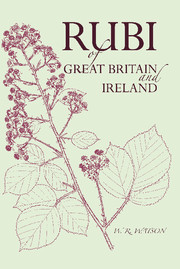Book contents
- Frontmatter
- Foreword
- Preface
- Contents
- INTRODUCTION
- I Environmental variations
- II Genetic intraspecific variations
- III Chromosomes and genes
- IV Reproduction
- V The species in Rubus
- VI Ecesis and migration
- VII Enemies, pests and diseases
- VIII Classification
- IX Collection and identification
- X Characteristics of the British-Irish bramble flora
- XI Cultivating native blackberries for fruit
- XII Note on the nomenclatural type species for the genus Rubus and subgenus Rubus
- XIII Key to the vice-county numbers
- XIV Signs and abbreviations
- ARRANGEMENT OF THE GENUS RUBUS LINN. IN AN ANALYTICAL KEY
- DESCRIPTIONS
- DRAWINGS
- Glossary
- Principal works consulted
- Index
XII - Note on the nomenclatural type species for the genus Rubus and subgenus Rubus
Published online by Cambridge University Press: 05 June 2016
- Frontmatter
- Foreword
- Preface
- Contents
- INTRODUCTION
- I Environmental variations
- II Genetic intraspecific variations
- III Chromosomes and genes
- IV Reproduction
- V The species in Rubus
- VI Ecesis and migration
- VII Enemies, pests and diseases
- VIII Classification
- IX Collection and identification
- X Characteristics of the British-Irish bramble flora
- XI Cultivating native blackberries for fruit
- XII Note on the nomenclatural type species for the genus Rubus and subgenus Rubus
- XIII Key to the vice-county numbers
- XIV Signs and abbreviations
- ARRANGEMENT OF THE GENUS RUBUS LINN. IN AN ANALYTICAL KEY
- DESCRIPTIONS
- DRAWINGS
- Glossary
- Principal works consulted
- Index
Summary
In choosing a type species to represent the genus Rubus and subgenus Rubus it will be the same species for each group. Obviously the species should be typical of the genus and of the subgenus, that is, it should not in any respect be contrary to the definition of the genus by Linnaeus.
Now Linnaeus himself indicates that two of his species are not typical: ‘Rubus Chamaemorus dioicus est; Rubus saxatilis acinis distinctis Baccas profert.’ (Gen. Plant, 6th ed., p. 254.)
R. saxatilis is atypical also in having a flat, not a conical receptacle, and very narrow, not subrotund petals. R. arcticus again must be disqualified, as it has a crumbling fruit like R. saxatilis, and a low convex, not a conical receptacle. R. caesius also fails to comply with the formula 'Acini Baccarum coaliti sunt nee sine laceratione distinguibiles', for the ripe fruit disintegrates when it is plucked. R. idaeus too is thoroughly atypical in its very narrow petals.
J. E. Smith (Eng. Fl. (1824), 11, 398) adopts for his type of Rubus fruticosusL. the specimen no. 5,’ Madera', representing this species in Herb. Linnaeus. Smith's description is R. ulmijolius and the Madeiran specimen is R. ulmijolius. There need be no hesitation, I consider, in adopting R. ulmijolius as the type species of genus Rubus and of subgenus Rubus; it has none of the disqualifying characters that have been mentioned.
RUBUS L. (type species R. ulmijolius Schott f.)
No epicalyx. Fruit a drupe, composed of pulpy drupels containing each a single, woody seed, inserted upon a spongy, flat or convex, conical or cylindrical, pitted receptacle. This runs down into a short central upgrowth from the flattish disc, which extends to the rim of the calyx tube. Calyx tube obsolescent, segments (4) 5 (6-8, 10), imbricate in bud, entire; petals of the same number as the calyx segments, very seldom more than 8 and then superposed, free, inserted on the rim of the calyx tube; stamens numerous, situated on the rim of the calyx tube, free but contiguous at the base, the filaments flattened or subulate, gradually or abruptly narrowed at their apex, the anthers versatile; styles subterminal, deciduous; ovules two, of which only one develops, the seed in most species pitted-reticulate. Pollen grains smooth, subglobose.
- Type
- Chapter
- Information
- Handbook of the Rubi of Great Britain and Ireland , pp. 24 - 26Publisher: Cambridge University PressPrint publication year: 2013



